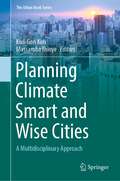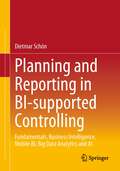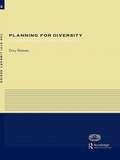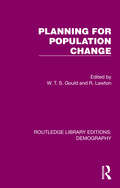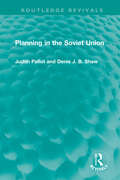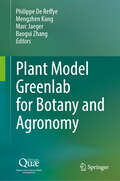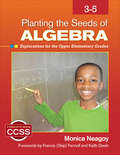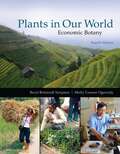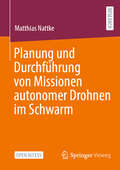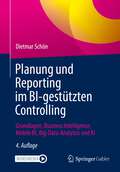- Table View
- List View
Planning Climate Smart and Wise Cities: A Multidisciplinary Approach (The Urban Book Series)
by Kwi-Gon Kim Massamba ThioyeThis book provides information that facilitates integrated climate actions in cities, leveraging disruptive technologies, business models, policies, financing, and leadership solutions. It fosters the development of climate smart and wise cities. It reviews the major developments of climate actions in cities and combines climate environment and energy technology, policy and financing instruments. A range of distinguished authors assess the experiences thus far and also consider future development from both theoretical and practical perspectives. They also discuss many policy and technical options, including climate smart and wise city planning, inclusion of urban nature, international and national carbon market mechanisms and measuring its impact and digital transformation. Moreover, attention is paid to the role of natural principles, the role of transparency principles and to aspects of democratic climate governance within a climate action scheme. This book makes clear that the carbon neutrality, sustainability, circularity, efficiency, connectivity and resiliency of cities depend to a large extent on the specific digital technologies and the leadership reshaping our cities.Discussing multidisciplinary aspects of climate action, this book offers new insights to academics, policymakers and practitioners both in the public and private sectors. Those insights are not only retrospective, relevant for understanding the past, but they are also prospective and forward-looking, guiding the achievements of the SDGs and the climate goals.
Planning and Reporting in BI-supported Controlling: Fundamentals, Business Intelligence, Mobile BI, Big Data Analytics and AI
by Dietmar SchönPlanning and reporting solutions in many companies still suffer from poor data quality, are insufficiently integrated and are often time and cost intensive. This practice-oriented book shows step by step how things can be done differently. It systematically shows how modern planning and reporting systems in BI-supported controlling can be set up with the use of data warehouse and big data technology and usefully supplemented with AI-supported features. For the 4th edition, the book has been comprehensively updated. The extensive controlling cockpit example has been expanded. It now contains suggestions for the areas of corporate management (operational and strategic controlling), sales, production, purchasing and project management. In addition, the latest developments in BI-supported controlling with the support of traditional and explorative BI are highlighted, including data mining, predictive analytics, artificial intelligence, RPA, chatbots, data discovery, data visualization, app technology, self-service BI and cloud computing. Further innovations concern the topics of data quality and data modeling. The final chapter is "Mobile BI", which deals with the expansion of powerful mobile analysis and planning solutions with the help of tablets, mobile phones and other mobile devices.
Planning for Diversity: Policy and Planning in a World of Difference (RTPI Library Series #Vol. 8)
by Dory ReevesThe practical importance of diversity and equality for spatial planning and sustainable development is still not widely understood. Using international examples, this book shows planners and educationalists the benefits of building in a consideration of diversity and equality at each stage and level of planning.Despite being one of the most diverse and gender balanced of the built environment professions, complacency has been widespread in planning. This book shows why a diverse profession is important and drawing on a wide range of good practice, shows how those involved in planning can develop their sensitivity to and expertise in diversity and equality.
Planning for Population Change (Routledge Library Editions: Demography #6)
by W. T. S. GouldOriginally published in 1986, this book explores many important aspects of the relationship between population change and planning, exploring the impact of population change on service provision and its impact on the policy-making process. In all countries, whether their population is expanding. ageing or stagnating, population mobility is an important cause of economic and social development. This book argues that there is a need for greater sensitivity about population change in policy-making and service provision and suggests ways of achieving this.
Planning in the Soviet Union (Routledge Revivals)
by Judith Pallot Denis J. ShawOriginally published in 1981 and based on the authors’ own research, this book provides a comprehensive review of planning in the Soviet Union up until the early 1980s for both geographers and Soviet specialists. Planning was particularly important in the Soviet Union since not only most spatial change, but all economic planning was the product of a systematic socio-political ideology. Planning was therefore the key to understanding the Soviet economy, society and spatial change. When it was first published, this was the first study in which the focus had been directed specifically at spatial planning in the Soviet Union in any systematic way.
Planning the Mexican Economy: Alternative Development Strategies (Routledge Revivals)
by Jorge BuzagloThe Mexican economy, like many other economies in the Third World, has grown as the result of a flourishing oil industry. One major problem which faces economic development planners in such economies is how to ensure that development in the oil sector leads on to more general development in the rest of the economy. Often, oil led development may induce agricultural stagnation, increasing food imports, inflation and income concentration.Planning the Mexican Economy (originally published in 1984), based on original research, looks at how this problem has been and might be faced in the Mexican economy. It uses econometric modelling to chart the relationship between different sectors of the economy and to show how change in one factor—such as income redistribution—affects other factors. It puts forward and compares different comprehensive development strategies and makes recommendations about the most effective approaches and policies.
Plant Model Greenlab for Botany and Agronomy
by Philippe De Reffye Mengzhen Kang Marc Jaeger Baogui ZhangThis book provides a general presentation of knowledge and methods in mathematical modelling and simulation of individual plants. The chapters mainly describe the algorithms of mathematical modelling, simulation and computer visualization and prospective aspects related to future developments of plant models. The book highlights the concepts coming from different disciplines and their mathematical integration to build robust, calibrated, and realistic integrative modeling solutions. Its original and groundbreaking focus is on the integration of structural and functional modeling for a living system such as a whole plant (or a crop field, a forest): most of the time, it has been believed among modeling practitioners that choices have to be made between the two, this belief no more prevails in the era of integrative (well-conceptually grounded) simulations. The content of this book is sufficient for a non-specialist to understand the fundamentals of mathematical modelling of plant architecture. Readers or even software developers can supplement their knowledge by consulting the book.
Planting the Seeds of Algebra, 3-5: Explorations for the Upper Elementary Grades
by Monica M. NeagoyGive your students a foundation of algebra for math success – now and in the future! Algebra is not something to be feared, but something to be embraced with a sense of wonder. Planting the Seeds of Algebra, 3-5, introduces algebra as an accessible way of seeing the world that is necessary to our students’ futures. Students and teachers must become friendly with algebraic foundations, as they have increasingly become the gateway to careers in the STEM fields. Monica Neagoy empowers teachers with theoretical and practical ways to introduce Algebra to 3-5 grade students, making vital connections to concepts they will encounter in middle school and beyond. You’ll discover Four explorations to help you weave key algebraic ideas into everyday mathematics Step-by-step lessons from real classrooms that will guide you in teaching concepts and in establishing their relevance and applicability New teaching methods that break down difficult algebraic concepts and build a critical foundation for higher math Awaken new awareness and change attitudes by sowing the seeds for a vibrant, useful, and rich experience with mathematics. "While reading this book I experienced the sense of wonder and aha moments alongside the students themselves. This book will move your faculty to new depths of understanding about mathematics and will instill the passion to explore a myriad of algebraic concepts." — Bob Weiman, Director St. Stephen’s & St. Agnes School "She’s done it again! Monica Neagoy has authored another book that deftly presents important foundations of algebra while celebrating mathematics through carefully crafted explorations, all of which include student and teacher vignettes and comments about the mathematics they have learned and are teaching. Wow. When I read this book I felt like I was in a classroom!" — Francis (Skip) Fennell, McDaniel College Past President of the National Council of Teachers of Mathematics
Planting the Seeds of Algebra, 3-5: Explorations for the Upper Elementary Grades
by Monica M. NeagoyGive your students a foundation of algebra for math success – now and in the future! Algebra is not something to be feared, but something to be embraced with a sense of wonder. Planting the Seeds of Algebra, 3-5, introduces algebra as an accessible way of seeing the world that is necessary to our students’ futures. Students and teachers must become friendly with algebraic foundations, as they have increasingly become the gateway to careers in the STEM fields. Monica Neagoy empowers teachers with theoretical and practical ways to introduce Algebra to 3-5 grade students, making vital connections to concepts they will encounter in middle school and beyond. You’ll discover Four explorations to help you weave key algebraic ideas into everyday mathematics Step-by-step lessons from real classrooms that will guide you in teaching concepts and in establishing their relevance and applicability New teaching methods that break down difficult algebraic concepts and build a critical foundation for higher math Awaken new awareness and change attitudes by sowing the seeds for a vibrant, useful, and rich experience with mathematics. "While reading this book I experienced the sense of wonder and aha moments alongside the students themselves. This book will move your faculty to new depths of understanding about mathematics and will instill the passion to explore a myriad of algebraic concepts." — Bob Weiman, Director St. Stephen’s & St. Agnes School "She’s done it again! Monica Neagoy has authored another book that deftly presents important foundations of algebra while celebrating mathematics through carefully crafted explorations, all of which include student and teacher vignettes and comments about the mathematics they have learned and are teaching. Wow. When I read this book I felt like I was in a classroom!" — Francis (Skip) Fennell, McDaniel College Past President of the National Council of Teachers of Mathematics
Planting the Seeds of Algebra, PreK–2: Explorations for the Early Grades
by Monica M. NeagoyHelp young minds explore algebraic concepts Algebra is the gateway to higher education, and preparing students to grasp algebraic concepts increases their opportunities to succeed. This book shows teachers how to create a strong foundation in algebra for very young children. Using in-depth math "explorations," the author unpacks—step by step—the hidden connections to higher algebra. Each exploration contains an elegantly simple grade-banded lesson (on addition, subtraction, patterns, and odd and even numbers), followed by a discussion of the algebra connections in the lesson, as well as suggestions for additional problems to explore. Throughout, readers will find: Clear explanations of algebraic connectionsSpecific strategies for teaching the key ideas of algebra Lesson modifications for older or younger studentsAn array of age-appropriate problems, games, and lessons Planting the seeds of Algebra, PreK–2 helps teachers foster mathematical habits of mind in students such as critical thinking, problem solving, adaptability, agility, communication, curiosity, and imagination. Growth in these ways of thinking and doing will transfer to other areas of education and life—raising the bar and challenging students to aspire.
Plants in our World: Economic Botany
by Beryl Simpson Molly OgorzalyThis one-semester text is designed for an upper level botany course. Plants in our World emphasizes how people use plants; including fundamental information on morphology, anatomy, and taxonomy as a foundation of general botany. Now in full color, the fourth edition includes molecular data that has immensely altered the understanding of relationships among flowering plants and recently pinpointed the origin of numerous crops. Taxonomy of species has been updated to discuss the system of the Angiosperm Phylogeny Group.
Planung und Durchführung von Missionen autonomer Drohnen im Schwarm
by Matthias NattkeDieses Open-Access-Buch behandelt die Missionsplanung autonomer Drohnenschwärme als verteiltes System. Sie wird als vielseitiges Werkzeug verstanden, das beschreibende, gestaltende und anwendungsorientierte Aspekte umfasst. Die Weiterentwicklung des UAV-Sektors erfordert interdisziplinäre Ansätze, um Herausforderungen zu bewältigen und neue Anwendungsfelder zu erschließen. Ein umfassendes Verständnis von UAV-Systemen ist essenziell, um deren Entwicklung und Einsatz effizient zu gestalten. Technische Systemaspekte, konzeptionelle Flugplanungen sowie sicherheitsrelevante Interaktionen während der Mission werden berücksichtigt. Ein Fokus liegt auf der Analyse der Interaktion zwischen Maschine und Fernpilot. Diese Erkenntnisse fließen in die Entwicklung einer Prozessarchitektur ein, die Konzepte und Vorschläge bietet. Iterative Prozesse optimieren das kooperative Fliegen und die Flugstabilität der Drohnen. Das Ergebnis ist ein fliegendes Sensornetzwerk mit vielseitigen Anwendungen.
Planung und Reporting im BI-gestützten Controlling: Grundlagen, Business Intelligence, Mobile BI, Big-Data-Analytics und KI
by Dietmar SchönPlanungs- und Reportinglösungen leiden in vielen Unternehmen immer noch unter mangelnder Datenqualität, sind unzureichend integriert und häufig zeit- und kostenintensiv. Dieses praxisorientierte Buch zeigt Schritt für Schritt, wie es anders geht. Es wird systematisch gezeigt, wie moderne Planungs- und Reportingsysteme im BI-gestützten Controlling mit dem Einsatz von Data-Warehouse- und Big-Data-Technologie aufgebaut und sinnvoll um KI-gestützte Features ergänzt werden können. Für die 4. Auflage wurde das Buch umfassend aktualisiert. Hierbei wurde das umfangreiche Controlling-Cockpit-Beispiel erweitert. Es enthält nun Vorschläge für die Bereiche Unternehmensleitung (operatives und strategisches Controlling), Vertrieb, Produktion, Einkauf und Projektsteuerung. Zudem werden die neusten Entwicklungen im BI-gestützten Controlling mit Unterstützung der traditionellen und explorativen BI aufgezeigt, u.a. Data Mining, Predictive Analytics, Künstliche Intelligenz, RPA, Chatbots, Data Discovery, Data Visualization, App-Technologie, Self Service BI sowie Cloud Computing. Weitere Neuerungen betreffen die Themen Datenqualität und Datenmodellierung. Den Abschluss bildet weiterhin das Kapitel „Mobile BI“, bei dem es um den Ausbau von leistungsfähigen mobilen Analyse- und Planungslösungen mit Hilfe von Tablets, Handys und anderen mobilen Endgeräten geht.
Planung und Reporting im BI-gestützten Controlling: Grundlagen, Business Intelligence, Mobile BI, Big-Data-Analytics und KI
by Dietmar Schön Maik DrozdzynskiPlanungs- und Reportinglösungen leiden in vielen Unternehmen immer noch unter mangelnder Datenqualität, sind unzureichend integriert und häufig zeit- und kostenintensiv. Dieses praxisorientierte Buch zeigt Schritt für Schritt, wie es anders geht. Es wird systematisch gezeigt, wie moderne Planungs- und Reportingsysteme im BI-gestützten Controlling mit dem Einsatz von Data-Warehouse- und Big-Data-Technologie aufgebaut und sinnvoll um KI-gestützte Features ergänzt werden können.
Plasma Atomic Physics (Springer Series on Atomic, Optical, and Plasma Physics #104)
by Frank B. Rosmej Valery A. Astapenko Valery S. LisitsaPlasma Atomic Physics provides an overview of the elementary processes within atoms and ions in plasmas, and introduces readers to the language of atomic spectra and light emission, allowing them to explore the various and fascinating radiative properties of matter. The book familiarizes readers with the complex quantum-mechanical descriptions of electromagnetic and collisional processes, while also developing a number of effective qualitative models that will allow them to obtain adequately comprehensive descriptions of collisional-radiative processes in dense plasmas, dielectronic satellite emissions and autoionizing states, hollow ion X-ray emissions, polarized atoms and ions, hot electrons, charge exchange, atomic population kinetics, and radiation transport. Numerous applications to plasma spectroscopy and experimental data are presented, which concern magnetic confinement fusion, inertial fusion, laser-produced plasmas, and X-ray free-electron lasers’ interaction with matter. Particular highlights include the development of quantum kinetics to a level surpassing the almost exclusively used quasi-classical approach in atomic population kinetics, the introduction of the recently developed Quantum-F-Matrix-Theory (QFMT) to study the impact of plasma microfields on atomic populations, and the Enrico Fermi equivalent photon method to develop the “Plasma Atom”, where the response properties and oscillator strength distribution are represented with the help of a local plasma frequency of the atomic electron density.Based on courses held by the authors, this material will assist students and scientists studying the complex processes within atoms and ions in different kinds of plasmas by developing relatively simple but highly effective models. Considerable attention is paid to a number of qualitative models that deliver physical transparency, while extensive tables and formulas promote the practical and useful application of complex theories and provide effective tools for non-specialist readers.
Plasma Theory: An Advanced Guide for Graduate Students
by Vladimir RozhanskyThis textbook, based on the author’s classroom-tested lecture course, helps graduate students master the advanced plasma theory needed to unlock results at the forefront of current research. It is structured around a two semester course, beginning with kinetic theory and transport processes, while the second semester is devoted to plasma dynamics, including MHD theory, equilibrium, and stability. More advanced problems such as neoclassical theory, stochastization of the magnetic field lines, and edge plasma physics are also considered, and each chapter ends with an illustrative example which demonstrates a concrete application of the theory. The distinctive feature of this book is that, unlike most other advanced plasma science texts, phenomena in both low and high temperature plasma are considered simultaneously so that theory of slightly ionized and fully ionized plasmas is presented holistically. This book will therefore be ideal as a classroom text or self-study guide for a wide cohort of graduate students working in different areas like nuclear fusion, gas discharge physics, low temperature plasma applications, astrophysics, and more. It is also a useful reference for more seasoned researchers.
Plasmonic Instabilities in Bidimensional Materials (Springer Theses)
by Pedro Afonso Cosme e SilvaThis book provides an in-depth analysis of the hydrodynamics of two-dimensional (2D) electronic systems, with a particular focus on graphene and other Dirac materials. It explores the theoretical framework and numerical simulations to uncover the potential of plasmonic instabilities in advancing nanotechnology. Moreover, the book also addresses the collective behaviour of quasiparticles in 2D materials and offers insights into the complex interplay between hydrodynamic behaviours and plasmonic phenomena. The main topics covered in this book include the hydrodynamic description of charge carriers, nonlinear waves, and topological effects in 2D electronic systems. It provides a comprehensive treatment of the Boltzmann equation to derive fluid-like transport equations, which are then used to study the collective responses and behaviours of these systems. The book also relies on the concept of electrostatic excitations, the plasmons, as an additional fluid and explores their effects and interplay with the charge carriers. One of the significant contributions of this book is the investigation of plasmonic instabilities and their potential applications in creating new active nanodevices, such as THz radiation sources. The theoretical findings are supported by extensive numerical simulations, providing a deeper understanding of the principles governing electronic flow in 2D materials. Further, this work also examines the nonlinear dynamics of electrohydrodynamics, revealing phenomena such as solitary waves, and the criteria for their occurrence. Lastly, the novel aspects of topological efects on the charge flow are also investigated. The importance of this work lies in its dual contribution to fundamental research and practical applications. On the theoretical side, it advances our understanding of the hydrodynamic regime of 2D materials and the transient and dynamic responses of these systems. On the practical side, it proposes novel device implementations, such as plasmonics oscillators and waveguides. On that topic, the book addresses the challenges of these devices, offering solutions to enhance controllability and to boost performance as well. This book is essential for graduate students, researchers, and professionals in the fields of quantum plasmas, 2D materials, and plasmonics. It is particularly valuable for plasma scientists interested in exploring 2D materials and condensed matter physicists who wish to study the hydrodynamic regime and the dynamic responses of these systems. By providing a detailed and comprehensive understanding of these advanced topics, this book paves the way for future research and technological innovations in the rapidly evolving fields of electrohydrodynamics and plasmonics.
Plasticity-Damage Couplings: From Single Crystal to Polycrystalline Materials (Solid Mechanics and Its Applications #253)
by Oana Cazacu Benoit Revil-Baudard Nitin ChandolaOffering a well-balanced blend of theory and hands-on applications, this book presents a unified framework for the main dissipative phenomena in metallic materials: plasticity and damage. Based on representation theory for tensor functions and scale-bridging theorems, this framework enables the development of constitutive models that account for the influence of crystallographic structures and deformation mechanisms on the macroscopic behavior. It allows readers to develop a clear understanding of the range of applicability of any given model, as well as its capabilities and limitations, and provides procedures for parameter identification along with key concepts necessary to solve boundary value problems, making it useful to both researchers and engineering practitioners. Although the book focuses on new contributions to modeling anisotropic materials, the review of the foundations of plasticity and models for isotropic materials, completed with detailed mathematical proofs mean that it is self-consistent and accessible to graduate students in engineering mechanics and material sciences.
Plate Tectonics: An Insider's History of the Modern Theory of the Earth (Frontiers in Physics)
by Naomi Oreskes<p>Can anyone today imagine the earth without its puzzle-piece construction of plate tectonics? The very term, "plate tectonics," coined only thirty-five years ago, is now part of the vernacular, part of everyone's understanding of the way the earth works. <p>The theory, research, data collection, and analysis that came together in the late 1960's to constitute plate tectonics is one of the great scientific breakthroughs of the 20th century. Scholarly books have been written about tectonics, but none by the key scientists-players themselves. In Plate Tectonics, editor Naomi Oreskes has assembled those scientists who played crucial roles in developing the theory to tell - for the first time, and in their own words - the stories of their involvement in the extraordinary confrimation of the theory. <p>The book opens with an overview of the history of plate tectonics, including in-context definitions of the key terms that are discussed throughout the book. Oreskes explains how the forerunners of the theory, Wegener and du Toit, raised questions that were finally answered thirty years later, and how scientists working at the key academic institutions - Cambridge and Princeton Universities, Columbia University's Lamont Doherty Geological Observatory, and the University of California-San Diego's Scripps Institution of Oceanography – competed and collaborated until the theory coalesced.
Plato, Diagrammatic Reasoning and Mental Models
by Susanna SaraccoThis book analyses the role of diagrammatic reasoning in Plato’s philosophy: the readers will realize that Plato, describing the stages of human cognitive development using a diagram, poses a logic problem to stimulate the general reasoning abilities of his readers. Following the examination of mental models in this book, the readers will reflect on what inferences can be useful to approach this kind of logic problem. Plato calls for a collaboration between writer and readers. In this book the readers will examine the connection between diagrams and discovery, realizing the important epistemic role of visualization. They will recognize the crucial role that diagrams play in problem solving. The logic problem elaborated by Plato is addressed considering the epistemic function of mental models. These models introduce to an advanced stage of cognitive development, in which reasoning uses in its investigations a higher-level of mathematical complexity, represented by structuralism.
Plato’s Problem
by Marco Panza Andrea SereniWhat is mathematics about? And if it is about some sort of mathematical reality, how can we have access to it? This is the problem raised by Plato, which still today is the subject of lively philosophical disputes. This book traces the history of the problem, from its origins to its contemporary treatment. It discusses the answers given by Aristotle, Proclus and Kant, through Frege's and Russell's versions of logicism, Hilbert's formalism, Godel's platonism, up to the the current debate on Benacerraf's dilemma and the indispensability argument. Through the considerations of themes in the philosophy of language, ontology, and the philosophy of science, the book aims at offering an historically-informed introduction to the philosophy of mathematics, approached through the lenses of its most fundamental problem. "
Play and STEM Education in the Early Years: International Policies and Practices
by Sue Dale Tunnicliffe Teresa J. KennedyThis edited book provides an overview of unstructured and structured play scenarios crucial to developing young children’s awareness, interest, and ability to learn Science, Technology, Engineering and Mathematics (STEM) in informal and formal education environments. The key elements for developing future STEM capital, enabling children to use their intuitive critical thinking and problem-solving abilities, and promoting active citizenship and a scientifically literate workforce, begins in the early years as children learn through play, employing trial and error, and often investigating on their own.Forty-seven STEM experts come together from 16 countries (Argentina, Australia, Belgium, Canada, England, Finland, Germany, Israel, Jamaica, Japan, Malta, Mauritius, Mexico, Russia, Sweden, and the USA) and describe educational policies and experiences related to young learners 3–4 years of age, as well as students attending formal-nursery school, early primary school, and the early years classes post 5 years of age.The book is intended for parents seeking to provide STEM activities for their children at home and in playgroups, citizen scientists seeking guidance to provide children with quality educational activities, daycare practitioners providing educational structures for young children from birth to formal education, primary school teachers and preservice teachers seeking to teach preschool, kindergarten or children typically aged 5–8 years old in grades 1–3, as well as researchers and policy makers working in science didactics with small children.
Playful Disruption of Digital Media (Gaming Media and Social Effects Ser.)
by Daniel Cermak-SassenrathThis book starts with the proposition that digital media invite play and indeed need to be played by their everyday users. Play is probably one of the most visible and powerful ways to appropriate the digital world. The diverse, emerging practices of digital media appear to be essentially playful: Users are involved and active, produce form and content, spread, exchange and consume it, take risks, are conscious of their own goals and the possibilities of achieving them, are skilled and know how to acquire more skills. They share a perspective of can-do, a curiosity of what happens next? Play can be observed in social, economic, political, artistic, educational and criminal contexts and endeavours. It is employed as a (counter) strategy, for tacit or open resistance, as a method and productive practice, and something people do for fun.The book aims to define a particular contemporary attitude, a playful approach to media. It identifies some common ground and key principles in this novel terrain. Instead of looking at play and how it branches into different disciplines like business and education, the phenomenon of play in digital media is approached unconstrained by disciplinary boundaries. The contributions in this book provide a glimpse of a playful technological revolution that is a joyful celebration of possibilities that new media afford. This book is not a practical guide on how to hack a system or to pirate music, but provides critical insights into the unintended, artistic, fun, subversive, and sometimes dodgy applications of digital media.Contributions from Chris Crawford, Mathias Fuchs, Rilla Khaled, Sybille Lammes, Eva and Franco Mattes, Florian 'Floyd' Mueller, Michael Nitsche, Julian Oliver, and others cover and address topics such as reflective game design, identity and people's engagement in online media, conflicts and challenging opportunities for play, playing with cartographical interfaces, player-emergent production practices, the re-purposing of data, game creation as an educational approach, the ludification of society, the creation of meaning within and without play, the internalisation and subversion of roles through play, and the boundaries of play.
Playful User Interfaces: Interfaces that Invite Social and Physical Interaction (Gaming Media and Social Effects)
by Anton NijholtThe book is about user interfaces to applications that have been designed for social and physical interaction. The interfaces are ‘playful’, that is, users feel challenged to engage in social and physical interaction because that will be fun. The topics that will be present in this book are interactive playgrounds, urban games using mobiles, sensor-equipped environments for playing, child-computer interaction, tangible game interfaces, interactive tabletop technology and applications, full-body interaction, exertion games, persuasion, engagement, evaluation and user experience. Readers of the book will not only get a survey of state-of-the-art research in these areas, but the chapters in this book will also provide a vision of the future where playful interfaces will be ubiquitous, that is, present and integrated in home, office, recreational, sports and urban environments, emphasizing that in the future in these environments game elements will be integrated and welcomed.
Playing Around Resonance
by Alessandro FondaThis book provides an up-to-date description of the methods needed to face the existence of solutions to some nonlinear boundary value problems. All important and interesting aspects of the theory of periodic solutions of ordinary differential equations related to the physical and mathematical question of resonance are treated. The author has chosen as a model example the periodic problem for a second order scalar differential equation. In a paedagogical style the author takes the reader step by step from the basics to the most advanced existence results in the field.
